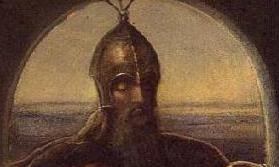
After Alfred the Great established the Danelaw north of Watling Street, the Norse transformed themselves from raiders of Britain into settlers of north Britain…mostly. As a result, the Viking chieftans ruled Northumbria for generations.
It is said that Siward might have come over with Canute, although others say his family had been in Britain for a few generations already. I like the Scandinavian legend that he was descended from a white bear and a lady. No wonder they called him “Siward the Strong”! Nonetheless, it is undisputed that Canute made him Earl of York sometime around 1031, and he ruled Northumbria until he died.
I have read that he was somehow related by marriage to Malcolm III, which made him either an uncle or cousin. When Macbeth killed Duncan and Prince Malcolm fled to England, it is believed he was taken in by Siward, who surely had it in his best interests to protect and nurture his future Royal neighbor. As events played out, Siward invaded Scotland on Malcolm’s behalf in 1054, and together they won a great battle at Dunsinane which sent Macbeth into exile and established Malcolm as King of Cumbria, for starters. Siward’s eldest son Osbeorn was killed in this battle.
Malcolm III became king of all Scotland after he eliminated both Macbeth and his stepson Lulach by the end of 1057. Alas, Siward did not live to see Malcolm’s victory. In 1055 he was stricken by dysentery, and as he lay on his sickbed, he bemoaned that after surviving so many battles he was forced to die like a cow. Siward insisted that he be dressed in his armor, put on a helmet and took to hand an axe and shield so he could at least die like a warrior. And so he passed from this world, leaving only a 10 year-old son Waltheof to survive him.
After the Norman Conquest, Malcolm was destined to meet Waltheof as a grown man and Earl of Northumbria, but was unable to return Siward’s favor and help Waltheof in his struggles against William the Conqueror. Poor Waltheof was the last of the so-called Anglo Saxon earls, and had the dubious distinction of being the only English aristocrat to be executed in William’s reign.
Tom Moss says:
Hi Mercedes,
Why was Siward called the Strong?
Was he the progenitor of the Armstrongs of Liddesdale in the Scottish Borders?
I think, they were first recorded in the Forest of Inglewood (modern Cumbria) as foresters but moved eventually to Liddesdale, the most dangerous place to enter in the time of the Border Reivers. They were feared for centuries.
There is a legend that they got their name for being strong.
Love your blog by the way,
Tom.
Mercedes Rochelle says:
Hi Tom. Thanks for the compliment! I have it on good authority (the honorable Edward A. Freeman) that Siward was so named because of his massive build and powerful fighting style. Sorry to say I have no knowledge of Liddesdale or the Armstrongs, so I’m perfectly happy to go along with you on this one!
Tim Elliott says:
The Scandinavian legend is generally viewed from the modern perspective, the story of the princess and the bear is considered mythical. This is probably not the right way to look at it. If viewed from the ancient Scandinavian perspective then a union between a bear and a princess would refer to a Berserk. A warrior of Odin who has a bear as his totem animal. As the Viking equivalent of nobility were often men of Odin, this is not as fanciful as it sounds.